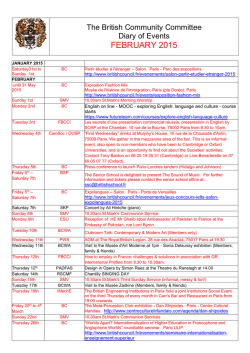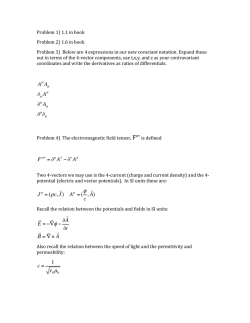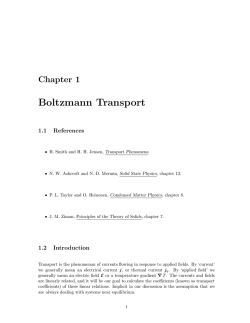
93. - Institute for Nuclear Theory
Nuclear 0 Physics North-Holland A398 (1983) 269-278 Publishing Company AN EFFECTIVE INTERACTION FOR INELASTIC SCATTERING DERIVED FROM THE PARIS POTENTIAL N. ANANTARAMAN, National Superconducting H. TOKI and G. F. BERTSCH Cyclotron Laboratory, .Michiyan State Uniuersity, East Lansing, Michigan 48824-1321, USA Received 11 November 1982 An effective interaction for inelastic scattering of nucleons from nuclei is derived by fitting oscillator G-matrix elements of the Paris nucleon-nucleon potential to the matrix elements of a sum of Yukawa terms. Except for the singlet-odd channel, these G-matrix elements do not differ in any significant respect from those obtained from the Reid soft-core potential, and give similar results for inelastic proton scattering. Abstract: 1. Introduction Some years ago, effective interactions for inelastic scattering of nucleons from nuclei were derived by Bertsch et ul. ‘) from the phenomenological nucleonnucleon (NN) potentials of Hamada and Johnston 2, and Reid 3). The derivation proceeded in two stages: the G-matrix elements of these potentials in an oscillator basis were first obtained, and then fitted to a sum of Yukawa terms. The effective interactions thus calculated were appropriate for use in nucleon scattering codes and have been applied to several inelastic nucleon scattering studies at bombarding energies up’to about 65 MeV [refs. “-“)I. A particular choice of the interaction which has come to be known 4, as M3Y has been especially popular. The purpose of the present paper is to describe a similarly motivated effective interaction derived from the Paris NN potential ‘), an-analytic form for which has recently been published ‘). The medium- and long-range parts of this potential are based upon a meson theory of nuclear forces, while the short-range part is fitted phenomenologically. The Paris potential is thus based on a more fundamental theory of the NN interaction than the earlier potentials. Moreover, new NN scattering data obtained in the 1970’s went into the development of this potential. The Reid soft-core potential is based on earlier and partially erroneous phase-shift data in the singlet-odd, triplet-even and spin-orbit-even channels ‘); and it has a much stronger tensor part than the Paris potential lo). It is of interest to study whether these differences in the basic NN potential lead to any significant changes in the effective interaction. The G-matrix elements that we obtain in the course of the derivation of the 269 N. Anantaraman 270 effective interaction are interesting applications, as nuclear parameters to inelastic such calculations force. In this paper, 2. Theoretical 2.1. G-MATRIX ELEMENTS interaction in their own right and can be used in different structure of the Landau-Migdal nucleon scattering. / Ef/ktice et al. IN THE HARMONIC and the extraction of the we focus on the application procedure OSCILLATOR BASIS From the Paris NN potential, G-matrix elements in the harmonic oscillator basis were obtained by the method of Barrett, Hewitt and McCarthy (BHM) l’). In order to clarify the method and the approximations used, the formalism developed by these authors is briefly outlined here. We start with the two-body hamiltonian H=H,+V, (I) where the zeroth-order hamiltonian H, provides the harmonic functions and energies by solution of the Schrodinger equation, H&r oscillator wave (2) = s,$,> for the two-body system. The nucleon-nucleon interaction V, which may be illbehaved around the origin of the relative coordinate, is then treated by the BetheGoldstone (BG) equation 12), Here the Pauli exclusion operator Q, ensures that neither of the two particles falls into the occupied states in the nuclear ground state. The reaction matrix G,,(w) is defined by the matrix elements of I/ between the unperturbed state 4p and the exact solution YzG: G,,(o) = (&,IU~:G(~)>. (4) The BG equation (3) is not very useful as it stands for constructing the G-matrix, for the procedure converges very slowly. BHM found it more convenient to introduce an expansion of YEG(o) in terms of the complete set of eigenfunctions tii of the Schrodinger equation (Ho + v)$i = E&i, YU,BG(co) = fai,(w)l/li. (5) N. Anantaraman By this means oscillator strong they expected expansion, short-range because repulsion et al. / EJfective interaction to get much better the functions convergence iji already part of V. Introducing 211 than contain further the harmonic the effect of the the overlaps (6) they arrived The reference at the following G-matrix expression for G by a straightforward in eq. (7) is defined manipulation: by G!,(o) = t&e--~)>i; 2 b&i,, L which can be easily computed. Eqs. (7) and (8) correspond to the standard relation 13) between the G-matrix and the reference matrix GK. The exact treatment of eqs. (5)-(s), and in particular the treatment of the Pauli operator, leads BHM to expressions which are complicated to deal with; see eqs. (28) and (29) of ref. l’). We prefer instead to use the approximation scheme introduced by Eden and Emery 14). By approximating the Pauli operator Q,,, they derive an integral equation for the G-matrix in only the relative coordinate, as we now discuss. Q, in eqs. (3) and (7) is a product of single-particle Pauli operators Q(2n +I) which are given by for for 2n+l 5 N,,, 2n + 1 > N,,,. Here N,,, is the principal quantum number and Emery replaced the exact Pauli operator Q, = Q(N,+N,) = Q(N+N) = ; (9) of the highest occupied Q, = Q(N1)Q(N2) by for for N+N N+N 5 2N,,,+2 > 2N,,,+2. level. Eden (10) Here N = 2n + I and N = 2fi +Tare the principal quantum numbers of the relative and center-of-mass wave functions, respectively. This prescription excludes the states wherein only one particle is excited from filled shells to the first or the second unfilled shell. However, the states with N, = N,,,+ 1, N, = N,,,+ 1, which should be allowed, are improperly excluded. Furthermore, all states (except a few) involving excitation to higher shells are allowed, whereas in fact those states N. Anantaraman 272 for which one of the particles et al. / Efftictiue interucrion is in a tilled shell should approximation seems to be a good one, but we shall return of the numerical results. We note that this approximation angle-averaged Pauli approximation in nuclear matter be excluded. The to it in the discussion is the analog of the theory I’). Using the above approximation for the Pauli operator and noting that the center-of-mass wave functions are not affected by the two-body potential V, we arrive at the G-matrix equation in only the relative coordinate r4): G,,(o) = G;,(w) - f G;@) 1_erlN:+A G,,(o). ’ P (11) u In eq. (1 l), as also in the earlier equations, all the suffixes are now to be considered to be those for the relative motion. The initial two-particle state is chosen to be one at the Fermi surface, since such states are the most important ones in nuclear structure calculations. Then iy, can be expressed in terms of the principal quantum numbers for relative motion using energy conservation : ho(N, Hence N, = 2N,,,- +N,) = hw(N,+N’,) N,. Substitution of this into the definition for for Now we are in a position wave function = 2N,,,hw. to discuss $i in eq. (5). The explicit [ -f?V2/m+$no2r2 (12) of Q(N + N) gives N, s NE+2 N, > N,+2. the Schrodinger (13) equation for the relative form is + V(r)]tii = Eitii, where the oscillator constant o depends on the nuclear system considered. potential V(r) in general contains central, spin-orbit, tensor and quadratic orbit terms 2,3,8). The equation is solved for eigenenergy E, and eigenfunction various two-nucleon channels (‘So, 3P,, coupled by the tensor term in V(r), a solved. Gi has a high degree of overlap G-matrix elements were obtained from (14) The spin$i in etc.). For the 3S, - 3D, channels, which are pair of coupled differential equations was with some oscillator function @“I. The free the relation 11,r5) G,q= (4,kW,~> = E-E,,, (15) where E,, is the oscillator energy in state 4,,[. They were then corrected for the Pauli blocking effect as discussed above. A special feature of the Paris potential is its momentum dependence. This could N. Ananfaraman et al. / Effective interaction 213 be treated readily by using the relation (x~x’)+(X-x~+~A)4(X-x~-~A),. II (16) This form led to the usual definition of the derivative, where A is a small distance. In fact, good numerical accuracy was achieved only with a very small value of A at small x: A = 0.01 fm for x 5 1 fm. The G-matrix elements in the ‘S, and ‘P, channels gave respectively the singleteven (SE) and singlet-odd (SO) components, while the coupled ‘S, -3D, channels gave the triplet-even (TE) and tensor-even (TNE) components. The triplet-odd (TO), tensor-odd (TNO), and the two components of the spin-orbit force were obtained from the following relations ‘), which are derived by ignoring the quadratic spin-orbit term : V(T0) = l’(3P,)+21’(LSO)+41’(TNO), l’(TN0) = -&[2V(3P,)-31’(3P,)+ l’(3P,)], V(LS0) = -~[21’(3P0)+31’(3P,)_51/(3P,)l, V(LSE) = $[l’(TE)-2V(TNE)2.2. FITTING OF EFFECTIVE INTERACTION l’(3D,)]. TO G-MATRIX (18) ELEMENTS The effective interaction was taken to be of the form central b’= 1 vY(r,,/R,)L. 1: c V:,Y(r,JRi)S,,, S, spin-orbit tensor, (19) where i 5 4, Y(x) = eTX/x, and the tensor operator S,, and the spin-orbit operator L. S have the conventional normalization. This is the form conventionally used in microscopic distorted wave programs for inelastic scattering of nucleons. The choice of the ranges was theoretically motivated, as discussed in ref. ‘), and satisfied the requirement that the central part of the interaction had the one-pion exchange potential tail. The strengths & were then determined by fitting to G-matrix elements in the various two-body channels by a least-squares fitting procedure. 274 N. Anantaraman et al. / Effective interaction 3. Results 3.1. G-MATRIX Because ELEMENTS of the momentum dependence of the Paris potential, the computer programming required to obtain the free G-matrix elements was more complicated than for the potentials used in ref. ‘). Some checks were therefore made on the programming. For the uncoupled channels, NN phase shifts were obtained from wave functions calculated in a very shallow oscillator potential (hw = 0.001 MeV) with a large value of 10 fm for the matching radius (beyond which the wave function was approximated by a plane wave). It was checked that these phase shifts agreed with the values listed in ref. *). For the coupled 3S,p3D, calculation, it was verified that the deuteron binding energy and wave function were correctly reproduced. The free G-matrix elements were calculated for an oscillator parameter hw = 14 MeV, which is appropriate for the region near 160. The next step was to correct them for the Pauli blocking effect. An energy gap of 40 MeV between occupied and unoccupied levels was used. The resulting effective G-matrix elements are listed in table 1, labelled by the radial quantum numbers n and n’ for the relative motion. As a check on the stability of these values, the effect of changing the energy gap to 30 MeV was investigated. This resulted in m 10 % change in the values quoted. The changes caused by replacing the Pauli blocking condition (10) by the requirement that Q, be zero for (N +m) s (N,,,+ 1) were also at the 10 % level. An independent check on these numbers is obtained from the variational calculation of G-matrix elements of the Paris potential performed by Vary 16), which should give an upper bound for these values. His numbers are in fact very close to ours. It is of interest to compare the effective G-matrix elements given in table 1 with the corresponding numbers from the Reid potential, which are given in ref. ‘) for the SE, TE, TNE and LSO channels. In these channels, the two sets of numbers agree with each other to within 10 ‘A, except for the case of the column headed n = 3 for the SE channel. For the SO, TO, TN0 and LSE channels, the matrix elements are smaller and are poorly determined by the NN interaction, which is why they are not given in ref. ‘). But we have computed them for both the Paris and the Reid potential and again find that they are in agreement with each other to about 10 %, except for the SO channel. This agreement in the two sets of numbers is worth emphasizing. It shows that the differences that exist between the Paris NN potential and the phenomenological Reid potential do not persist in the corresponding G-matrix elements, which are the quantities of interest in most applications. We note in particular that the matrix elements in the tensor-even and tensor-odd channels are very similar. Only for the SO channel and in the case of the column headed n = 3 for the SE channel are there significant differences. But, since they occur mainly for highly nondiagonal matrix elements, these differences should not noticeably affect inelastic scattering results. N. Anantaraman et al. / Effective 275 interaction TABLE 1 Oscillator G-matrix 1 2 3 n’ = 0 -6.13 - 5.27 -4.84 - 3.73 - 3.47 -2.61 - 11.28 - 6.46 - 1.44 2.51 n=O 1 2 3 -9.63 - 8.90 - 8.43 - 7.55 - 6.82 - 5.83 n=O 1 2 3 2.31 3.03 2.11 3.00 3.39 1.89 2.81 3.41 3.14 1 2 3 1 2 3 S n’ = 0 1 2 3 P P singlet odd n’ = 0 1 2 3 P P triplet odd n’ = 0 1 2 3 2.52 n=O - U.08 -0.23 -0.24 n=O tensor even n’ = 0 1 2 3 P tensor odd (ho = 14 MeV) n=O s triplet even (in MeV) of the Paris potential s s singlet even elements P a’ = 0 1 2 - 5.54 -2.61 - 1.35 -0.72 n=O 0.78 - 0.09 -0.05 0.04 - - 0.05 0.01 0.13 0.3 1 - 9.21 8.11 6.23 4.39 2 - 1.62 -5.09 - 2.95 - 1.66 - 8.66 - 6.90 -4.12 - 2.98 1 2 3 0.63 0.87 0.95 0.54 0.79 0.93 0.75 0.92 3 D LS D n’ = 0 even LS odd 1.00 n=O -0.14 1 2 3 P P n' = 0 1 2 3 6.07 5.63 5.02 2.82 1 -0.13 -0.18 2 -0.12 -0.21 - 0.26 n=O 1 2 -0.57 -0.90 - 1:28 - 0.96 - 1.40 - 1.71 3 - 0.21 0.47 0.70 0.91 3 - 1.06 1.55 1.91 2.19 N. Ananraraman et al. / Effective interaction 276 3.2. EFFECTIVE INTERACTION FOR INELASTIC SCATTERING A least-squares fitting of the effective G-matrix elements in the various channels to a set of Yukawa potentials with at most four ranges was performed. This was done to facilitate use with the inelastic scattering program DWBA70 [ref. “)I, which can handle a sum of central, tensor and spin-orbit components of the form expressed by eq. (19). The choice of the ranges was physically motivated, as discussed in ref. ‘), and consisted of 0.25, 0.4, 0.7 and 1.414 fm. The one-pion exchange potential strength was imposed on the 1.414 fm part of the central interaction, as required by the meson theory of nuclear forces. The results are shown in table 2 where, for each channel, two rows of interaction strengths are given. The first row is that derived from the Paris potential, the second that from the Reid potential. The latter numbers are those given in ref. ‘) for the SE, TE and TNE channels; for other channels, they have been obtained ab initio. The similarity of the two sets of numbers in most of the channels is noteworthy, It again indicates that the differences that exist between the Paris potential and the Reid potential will not show up to the same extent in inelastic scattering results. We verify this quantitatively in the next section. The central odd components are the most poorly determined parts of the interaction, as reflected in the very different strengths of the Yukawa interactions derived from the Reid and Paris potentials. It is also reflected in the rather small values of the effective Gmatrix elements found for the SO and TO channels (table 1). TABLE 2 Best-fit interaction strengths (in MeV) Channel Name R, = 0.25fm R, = 0.4Ofm SE Paris Reid Paris Reid Paris Reid Paris Reid Paris Reid Paris Reid Paris Reid Paris Reid 11466 12455 13967 21227 - 1418 29580 11345 12052 -3556 - 3835 -4594 - 6622 950 - 3464 -1900 - 1990 - 1096 - 1260 244 263 - 337 - 352 - 632 - 483 TE so TO TNE TN0 LSE LSO -5101 -4382 - 1897 -2918 R, = 0.7 fm R, = 1.414fm - - 30.9 -28.4 15.6 13.8 10.463 10.463 10.463 10.463 31.389 31.389 3.488 3.488 N. Anantaraman et al. / Effectiae interaction 277 4. Application Inelastic scattering DWBA70 for various cross sections were computed with the microscopic code levels excited in the 24Mg(p, p’) reaction. Zwieglinski et al. 5, have studied this reaction experimentally at 40 MeV and also analyzed it microscopically using a particular choice of the interactions given in ref. ‘). They used detailed shell-model wave functions from Chung and Wildenthal i8) for the levels of 24Mg. We have repeated this analysis, and also performed similar calculations using the two sets of interaction listed in table 2. The shapes of the angular distributions calculated with all three sets of interaction are identical. We do not show them here, as they have already been published in ref. 5). The normalizations N, defined as the ratio CX_,/~~~,~, are similar for the three interactions. Table 3 lists the values of N obtained for some of the states in 24Mg. These states have been selected to explore the behavior of the effective interaction in T = 0 and T = 1 channels, for both spin-flip (odd J) and non-spin-flip (even J) transitions. The departure of N from unity has been attributed 5, to core polarization effects. We note that in all these four channels, the different interactions give similar normalizations. Thus the effective interaction for inelastic scattering obtained from the Paris potential is very similar to the interactions derived from the earlier, phenomenological potentials. This result is consistent with the finding of Chakravarti et a/. 19) regarding the effective charge and interaction in the sd shell. They too find that the results from the Paris potential are close to those obtained previously with the Reid soft-core potential. In conclusion, nuclear structure models favor interactions with very strong exchange, and we had hoped that the new potentials based on better P-wave phase shifts would improve the exchange character of the effective interaction. However, the difference between the older G-matrix elements and the newer ones is small, and no improvement is found in the effective interaction at the level of the Gmatrix. TABLE 3 Normalizations for levels populated J”T NW 2’0 3+0 2+1 3+1 2.67 4.83 2.64 1.69 “) Values obtained present authors. using the interaction and method in Z4Mg(p, p’) at 40 MeV NParis Nzwisg~insri=’ 2.74 4.95 2.69 1.67 3.89 6.04 3.20 1.82 of ref. ‘) but with normalizations done by the 278 N. Anantaraman et al. / Effective interaction We thank Dr. J. P. Vary for a helpful by the US National Science Foundation discussion. This work has been supported under grant no. PHY80-17605-05. References 1) 2) 3) 4) 5) 6) 7) 8) 9) 10) 11) 12) 13) 14) 15) 16) 17) 18) 19) G. Bertsch, J. Borysowicz, H. McManus and W. G. Love, Nucl. Phys. A284 (1977) 399 T. Hamada and I. D. Johnston, Nucl. Phys. 34 (1962) 382 R. Reid, Ann. of Phys. SO (1968) 411 W. G. Love, The (p. n) reaction and the nucleon-nucleon force, ed. C. D. Goodman et al. (Plenum, New York, 1980) p. 23 B. Zwieglinski, G. M. Crawley, W. Chung, H. Nann and J. A. Nolen, Phys. Rev. Cl8 (1978) 1288 G. P. A. Berg, W. Htirlimann, I. Katayama, S. A. Martin, J. Meissburger, J. Riimer, B. Styczen, F. Osterfeld, G. Gaul, R. Santo and G. Sondermann, Phys. Rev. C25 (1982) 2100 R. Vinh Mau, Mesons in nuclei, vol. 1, ed. M. Rho and D. H. Wilkinson (North-Holland, Amsterdam, 1979) p. 151 M. Lacombe, B. Loiseau, J. M. Richard, R. Vinh Mau, J. Cote, P. Piresand R. deTourrei1, Phys. Rev. C21 (1980) 861 P. Signell, in The (p, n) reaction and the nucleon-nucleon force, ed. C. D. Goodman et al. (Plenum, New York, 1980) p. 1 A. Arima, Nucl. Phys. A354 (1981) 19 B. R. Barrett, R. G. L. Hewitt and R. J. McCarthy, Phys. Rev. C3 (1971) 1137 H. A. Bethe, Ann. Rev. Nucl. Sci. 21 (1971) 93 H. A. Bethe, B. H. Brandow and A. G. Petschek, Phys. Rev. 129 (1963) 225 R. J. Eden and V. J. Emery, Proc. Roy. Sot. London A248 (1958) 266 G. F. Bertsch, The practitioner’s shell model (North-Holland, Amsterdam, 1972) p. 78 J. P. Vary, private communication R. Schaeffer and J. Raynal, unpublished W. Chung and B. H. Wildenthal, unpublished S. Chakravarti, P. J. Ellis, T. T. S. Kuo and E. Osnes, Phys. Lett. 109B (1982) 141
© Copyright 2025







